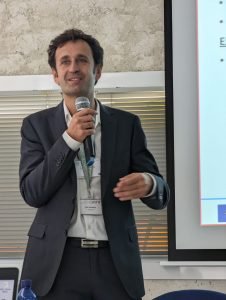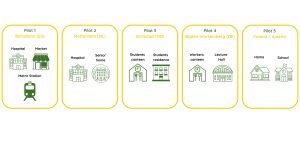

José Fermoso Domínguez, Programme Manager, Natural Resources and Climate Area, CARTIF and K-HEALTHinAIR Project Coordinator
[fusion_separator style_type="single solid" hide_on_mobile="small-visibility,medium-visibility,large-visibility" sticky_display="normal,sticky" class="" id="" flex_grow="0" top_margin="10" bottom_margin="10" width="" alignment="center" border_size="" sep_color="var(--awb-color8)" hue="" saturation="" lightness="" alpha="" icon="" icon_size="" icon_color="" icon_circle="" icon_circle_color=""][/fusion_separator]
We have been working for some years measuring outdoor and indoor air quality (IAQ) and trying to research and develop useful technologies to capture the main pollutants. There are multiple sources of air pollution, both indoors and outdoors, most of them are quite common, and many times are perceived as almost innocuous for health by people. Besides, air pollution usually is “invisible” to the human eye, so we need external support to evaluate it. The European Commission’s call for proposals on Environment and health (2021) (HORIZON-HLTH-2021-ENVHLTH-02) did the rest, allowing us to join a multidisciplinary group of researchers and professionals to conceive the idea behind K-HEALTHinAIR. This project’s consortium's aim is to design and implement all the needed steps to improve knowledge about IAQ and develop solutions that will support the achievement of healthier indoor environments.
We distinguish the identification of pollutants between those affecting health and wellbeing at medium or long term and the ones provoking acute effects. Then, we selected 9 relevant indoor environments and looked for representative spaces in different countries (2 hospitals, one in Barcelona, Spain, and one in Rotterdam, The Netherlands, some schools in Poland and in Austria, one metro station in Barcelona, etc.) and configured a three years monitoring campaign combining sampling techniques for the main parameters and also the use of monitoring tools. Making use of Machine Learning techniques and additional sources of information we will try to identify the determinants for each scenario/setting and implement algorithms to improve the performance of the monitoring tools.

During the project, particular attention will be paid to some vulnerable groups, such as high-risk outpatients. Certain air pollutants appear to be responsible for the acute effects these outpatients experience in their daily lives. While some of these correlations are fairly well known, others are still entirely unknown and deserve further research efforts. A special plan will be followed to monitor these outpatients using different techniques, to identify as many determinants as possible causing acute effects.
The usability of easy-to-use IAQ monitors will be focused on supporting ventilation or HVAC (heating, ventilation and air conditioning) management, in order to avoid human health risks in indoor spaces. s. We will try to provide these monitors with capacity to give advice based on the knowledge created during the project. The determinants identified during K-HEALTHinAIR, and their sources, will guide the protocols to be applied for each kind of indoor space.
For vulnerable people, as mentioned above, the project will work on developing additional technologies. Further details on this critical task will be provided at a later stage.